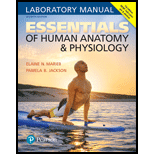
Introduction:
The building blocks of all the elements present in the universe are known as atoms, which are invisible to the naked eye. An atom, in turn, is composed of much smaller particles known as subatomic particles. The atom is divided into two main regions, including nucleus and a peripheral region. The subatomic particles, electrons, protons, and neutrons, are distributed in these two regions inside the atom.
Answer to Problem 1MC
Correct answer:
The nucleus containing the subatomic particles determines the mass of the atom. These subatomic particles determine the atomic number of the atom.
Explanation of Solution
Explanation for correct answers:
Option (a) is given that the atomic nucleus contains the atom’s mass. The nucleus contains the neutrons and protons, which hold the majority portion of the weight of the atom. The negatively charged electrons that move around the nucleus in their respective orbitals are nearly massless. Hence, option (a) is correct.
Option (c) is given that the subatomic particles can be ejected from the nucleus. Two forces work within an atom:
Option (d) is given that the atomic number is determined by the subatomic particles contained within the nucleus. The atomic number is denoted by the number of protons present within the nucleus, which is unique for each element. Hence, option (d) is correct.
Explanation for incorrect answers:
Option (b) is given that the negatively charged subatomic particles are present in the nucleus. The electrons that carry the negative charge move around the nucleus in fixed orbits. The number of protons is equal to the number of electrons present in the nucleus. So, it is an incorrect option.
Option (e) is given that the subatomic particles present within the nucleus interact with other atoms. The protons that are present within the nucleus are confined in their region and do not leave the nucleus unless there are strong nuclear forces. The electrons are mainly responsible for the interaction with other atoms by either sharing or transferring electrons. So, it is an incorrect option.
Hence, options (b) and (e) are incorrect.
Thus, the nucleus having the protons along with the neutrons makes up the mass of the atom. These subatomic particles can also be ejected from the nucleus under certain circumstances, which ultimately leads to the decay of the atom. The atomic number depends on the number of protons present within the nucleus.
Want to see more full solutions like this?
Chapter 2 Solutions
Essentials of Human Anatomy & Physiology Laboratory Manual (7th Edition)
- What is behavioral adaptarrow_forward22. Which of the following mutant proteins is expected to have a dominant negative effect when over- expressed in normal cells? a. mutant PI3-kinase that lacks the SH2 domain but retains the kinase function b. mutant Grb2 protein that cannot bind to RTK c. mutant RTK that lacks the extracellular domain d. mutant PDK that has the PH domain but lost the kinase function e. all of the abovearrow_forwardWhat is the label ?arrow_forward
- Can you described the image? Can you explain the question as well their answer and how to get to an answer to an problem like this?arrow_forwardglg 112 mid unit assignment Identifying melting processesarrow_forwardGive only the mode of inheritance consistent with all three pedigrees and only two reasons that support this, nothing more, (it shouldn't take too long)arrow_forward
- Oarrow_forwardDescribe the principle of homeostasis.arrow_forwardExplain how the hormones of the glands listed below travel around the body to target organs and tissues : Pituitary gland Hypothalamus Thyroid Parathyroid Adrenal Pineal Pancreas(islets of langerhans) Gonads (testes and ovaries) Placentaarrow_forward
 Principles Of Radiographic Imaging: An Art And A ...Health & NutritionISBN:9781337711067Author:Richard R. Carlton, Arlene M. Adler, Vesna BalacPublisher:Cengage Learning
Principles Of Radiographic Imaging: An Art And A ...Health & NutritionISBN:9781337711067Author:Richard R. Carlton, Arlene M. Adler, Vesna BalacPublisher:Cengage Learning Biology Today and Tomorrow without Physiology (Mi...BiologyISBN:9781305117396Author:Cecie Starr, Christine Evers, Lisa StarrPublisher:Cengage Learning
Biology Today and Tomorrow without Physiology (Mi...BiologyISBN:9781305117396Author:Cecie Starr, Christine Evers, Lisa StarrPublisher:Cengage Learning Biology (MindTap Course List)BiologyISBN:9781337392938Author:Eldra Solomon, Charles Martin, Diana W. Martin, Linda R. BergPublisher:Cengage Learning
Biology (MindTap Course List)BiologyISBN:9781337392938Author:Eldra Solomon, Charles Martin, Diana W. Martin, Linda R. BergPublisher:Cengage Learning
 Human Biology (MindTap Course List)BiologyISBN:9781305112100Author:Cecie Starr, Beverly McMillanPublisher:Cengage Learning
Human Biology (MindTap Course List)BiologyISBN:9781305112100Author:Cecie Starr, Beverly McMillanPublisher:Cengage Learning





